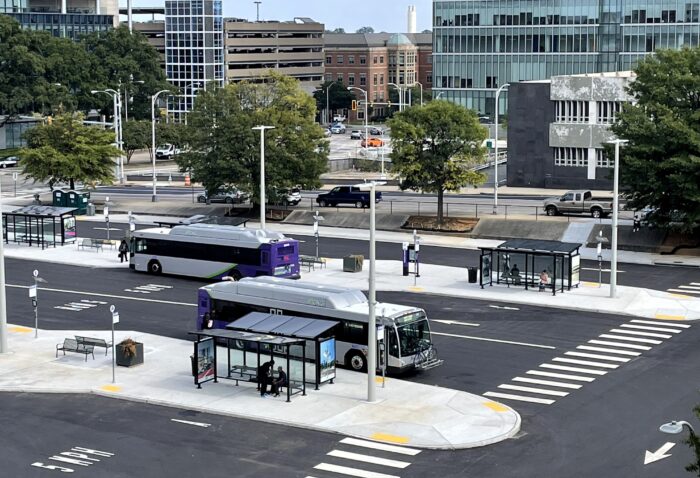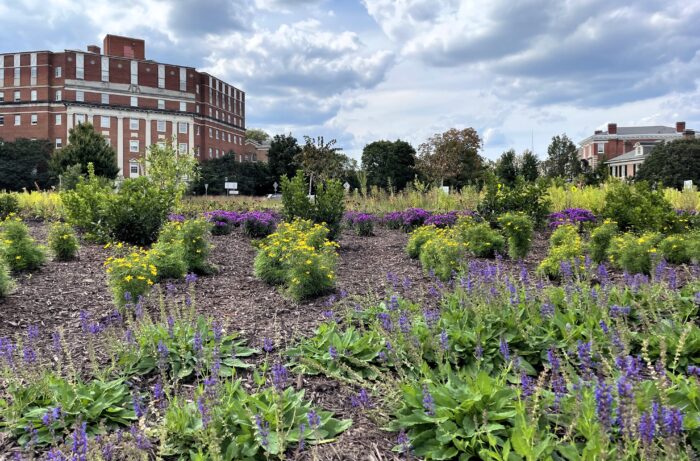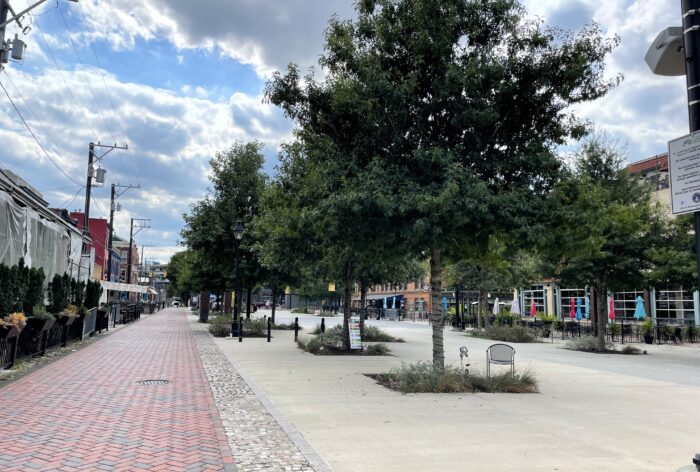“We’re becoming more like Northern Virginia every day” is an oft-heard refrain here. Few would dispute that Richmond is ever changing and growing.
But it’s not just ground-up construction and dense, taller and generic structures that signal physical expansion. Unlike some points north, our town has architectural depth that can translate into century-old places being repurposed. Such is the case with three public outdoor spaces that have gotten recent face-lifts. A downtown parking lot at Clay and Eighth streets has become the Greater Richmond Transit Company bus plaza. The traffic circle at Monument and Allen avenues, that once displayed a bronze likeness of Robert E. Lee and his steed, Traveler, is now a decorative and densely planted garden. And the 17th Street Market in Shockoe Bottom wouldn’t be recognizable to those who haven’t ventured out since the COVID-19 pandemic.
It’s a mark of Richmond’s age, economics and shifting civic values that such prime real estate has been reworked.
Since Sept. 11, riders have boarded and been discharged from GRTC buses on what was once the football 50-yard line of the former John Marshall High School football stadium. Who knew? The transfer plaza’s block, defined by Eighth, Ninth, Clay and Leigh streets, was most recently a surface parking lot whose asphalt had been laid decades ago atop the athletic field (the school building and playing field were operational from 1909 to 1960, when the school moved to Northside). The transfer station’s tightly configured, 12-bay setup replaces the inadequate former depot situated across Ninth Street in the shadow of the city’s crumbling safety and welfare building. The new plaza is slightly sunken and delineated on three sides by continuous and sloping concrete slabs – physical indications of where stadium bleachers once stood.
Two rectangular pedestrian islands are at the center of the complex. Each isle has six bays for buses that enter and exit via Eighth Street. I have transferred buses five or six times now and can report that the configuration and timing of arrivals and departures work splendidly. Buses roll in and out with an unexpectedly pleasant rhythm. Often-harried riders are the winners from the plaza’s compactness. Eight modest-sized, well-positioned bus shelters provide somewhat more protection from the elements than was previously offered. Electronic tracking screens at each bay provide updates on the comings and goings of respective buses. And large framed posters that adorn each shelter include highly attractive photographs that reinforce the concept of bus riding.
The new plaza should be a positive game changer for riders.
That said, bus drivers are still perfecting tighter turns. And some patrons would prefer brighter lighting after dark. But it’s the ramp-like, sloped, concrete bunkers lining the plaza near the city sidewalks along Ninth, Leigh and part of Eighth streets that are the most concerning feature. With pedestrian entrances to the plaza limited to three corners, I noticed several nimble-footed patrons, from nearby government buildings, the VCU Health center and the Biotech Park, entering midblock by either sliding down, or gingerly hopping across, the steep embankments. Ice or snow will worsen the situation. A minimal metal safety railing installed along the Ninth Street side should be extended to Leigh and part of Eighth Street.
GRTC officials say that the transfer plaza is a temporary installation.
For the benefit of those who have either been under a rock or just moved here, the looming equestrian statue of Gen. Robert E. Lee that had occupied the grassy circle at the crossing of Monument and Allen avenues for 130 years is gone. The Black Lives Matter movement and other forces brought its removal, and statues of four other Confederate pooh-bahs, to points unknown. All the statues’ plinths or bases were removed and four of the negative spaces have been landscaped. The mostly low-lying plant and shrub scheme was designed and installed by YME Landscaping (Thomas “Stonewall” Jackson’s former spot in the intersection of Monument and Arthur Ashe Boulevard is now an asphalt traffic lane).
Since the former Lee Circle is considerably larger than the other reworked traffic islands, it could have become a small park. Previously, its grassy lawn was popular with dog walkers, Frisbee throwers, and sunbathers. And more recently, protesters squatted here. Apparently not keen on having the circle reoccupied, planners installed a dense and attractive thicket of plantings that completely fills the circle. It’s not quite a briar patch, but that’s the idea.
Reportedly, this landscaping scheme is also a temporary situation.
The third recently reconsidered public space, the 17th Street Market, has been operational since 2019 but was denied a proper launch because of the pandemic. The beloved former farmers market had operated in Shockoe Bottom since the 18th century (and occupied a succession of covered structures throughout that period). The new multiuse plaza, designed by the Baskervill architecture firm and the landscaping firms of Tillage Studio and Spatial Affairs, has been designed for flexibility and changing special events. It also boasts mature oak trees (with a specially installed watering system) that create a welcome green canopy in this often-muggy, low-lying district.
Programming has been well-curated this summer by the city’s recreation and parks department. In August, an ambitious music block party, “804 Day,” brought three main stages and an impressive crowd to the market. More recently, I happened by 17th Street to find a tuxedo-wearing big band blasting away from a tented stage backed up to East Main Street. Spectators brought their own chairs. Williamsburg-based Good Shot Judy had the audience of about 100 hopping and dancing. It was the September offering of rec and parks’ ongoing “Sounds of 17th” series.
As the program drew to a close, almost the entire audience formed a conga line that shook and shimmied its way across the concrete pavement. Fifty other listeners lounged under the umbrellas of nearby restaurant patios. One 20-something man, all smiles and sweat from having joined the conga, returned to two lady friends seated under a Rosie Connolly’s Pub and Restaurant umbrella. He and his girlfriend, plus a pal from Philadelphia, had strolled down from nearby Union Hill. Across the market, an elated, perspiring, middle-aged woman swept in their direction, toward the bar indoors. She and her friends and neighbors had come over from nearby Rocketts Landing. She gushed: “This is the best thing the city has ever done.”
On Oct. 6, “Sounds of 17th” presents Gone Country.
Audiences seem pleased and the handsome shade trees are doing well, so this most recent iteration of the 17th Street Market seems permanent.
“We’re becoming more like Northern Virginia every day” is an oft-heard refrain here. Few would dispute that Richmond is ever changing and growing.
But it’s not just ground-up construction and dense, taller and generic structures that signal physical expansion. Unlike some points north, our town has architectural depth that can translate into century-old places being repurposed. Such is the case with three public outdoor spaces that have gotten recent face-lifts. A downtown parking lot at Clay and Eighth streets has become the Greater Richmond Transit Company bus plaza. The traffic circle at Monument and Allen avenues, that once displayed a bronze likeness of Robert E. Lee and his steed, Traveler, is now a decorative and densely planted garden. And the 17th Street Market in Shockoe Bottom wouldn’t be recognizable to those who haven’t ventured out since the COVID-19 pandemic.
It’s a mark of Richmond’s age, economics and shifting civic values that such prime real estate has been reworked.
Since Sept. 11, riders have boarded and been discharged from GRTC buses on what was once the football 50-yard line of the former John Marshall High School football stadium. Who knew? The transfer plaza’s block, defined by Eighth, Ninth, Clay and Leigh streets, was most recently a surface parking lot whose asphalt had been laid decades ago atop the athletic field (the school building and playing field were operational from 1909 to 1960, when the school moved to Northside). The transfer station’s tightly configured, 12-bay setup replaces the inadequate former depot situated across Ninth Street in the shadow of the city’s crumbling safety and welfare building. The new plaza is slightly sunken and delineated on three sides by continuous and sloping concrete slabs – physical indications of where stadium bleachers once stood.
Two rectangular pedestrian islands are at the center of the complex. Each isle has six bays for buses that enter and exit via Eighth Street. I have transferred buses five or six times now and can report that the configuration and timing of arrivals and departures work splendidly. Buses roll in and out with an unexpectedly pleasant rhythm. Often-harried riders are the winners from the plaza’s compactness. Eight modest-sized, well-positioned bus shelters provide somewhat more protection from the elements than was previously offered. Electronic tracking screens at each bay provide updates on the comings and goings of respective buses. And large framed posters that adorn each shelter include highly attractive photographs that reinforce the concept of bus riding.
The new plaza should be a positive game changer for riders.
That said, bus drivers are still perfecting tighter turns. And some patrons would prefer brighter lighting after dark. But it’s the ramp-like, sloped, concrete bunkers lining the plaza near the city sidewalks along Ninth, Leigh and part of Eighth streets that are the most concerning feature. With pedestrian entrances to the plaza limited to three corners, I noticed several nimble-footed patrons, from nearby government buildings, the VCU Health center and the Biotech Park, entering midblock by either sliding down, or gingerly hopping across, the steep embankments. Ice or snow will worsen the situation. A minimal metal safety railing installed along the Ninth Street side should be extended to Leigh and part of Eighth Street.
GRTC officials say that the transfer plaza is a temporary installation.
For the benefit of those who have either been under a rock or just moved here, the looming equestrian statue of Gen. Robert E. Lee that had occupied the grassy circle at the crossing of Monument and Allen avenues for 130 years is gone. The Black Lives Matter movement and other forces brought its removal, and statues of four other Confederate pooh-bahs, to points unknown. All the statues’ plinths or bases were removed and four of the negative spaces have been landscaped. The mostly low-lying plant and shrub scheme was designed and installed by YME Landscaping (Thomas “Stonewall” Jackson’s former spot in the intersection of Monument and Arthur Ashe Boulevard is now an asphalt traffic lane).
Since the former Lee Circle is considerably larger than the other reworked traffic islands, it could have become a small park. Previously, its grassy lawn was popular with dog walkers, Frisbee throwers, and sunbathers. And more recently, protesters squatted here. Apparently not keen on having the circle reoccupied, planners installed a dense and attractive thicket of plantings that completely fills the circle. It’s not quite a briar patch, but that’s the idea.
Reportedly, this landscaping scheme is also a temporary situation.
The third recently reconsidered public space, the 17th Street Market, has been operational since 2019 but was denied a proper launch because of the pandemic. The beloved former farmers market had operated in Shockoe Bottom since the 18th century (and occupied a succession of covered structures throughout that period). The new multiuse plaza, designed by the Baskervill architecture firm and the landscaping firms of Tillage Studio and Spatial Affairs, has been designed for flexibility and changing special events. It also boasts mature oak trees (with a specially installed watering system) that create a welcome green canopy in this often-muggy, low-lying district.
Programming has been well-curated this summer by the city’s recreation and parks department. In August, an ambitious music block party, “804 Day,” brought three main stages and an impressive crowd to the market. More recently, I happened by 17th Street to find a tuxedo-wearing big band blasting away from a tented stage backed up to East Main Street. Spectators brought their own chairs. Williamsburg-based Good Shot Judy had the audience of about 100 hopping and dancing. It was the September offering of rec and parks’ ongoing “Sounds of 17th” series.
As the program drew to a close, almost the entire audience formed a conga line that shook and shimmied its way across the concrete pavement. Fifty other listeners lounged under the umbrellas of nearby restaurant patios. One 20-something man, all smiles and sweat from having joined the conga, returned to two lady friends seated under a Rosie Connolly’s Pub and Restaurant umbrella. He and his girlfriend, plus a pal from Philadelphia, had strolled down from nearby Union Hill. Across the market, an elated, perspiring, middle-aged woman swept in their direction, toward the bar indoors. She and her friends and neighbors had come over from nearby Rocketts Landing. She gushed: “This is the best thing the city has ever done.”
On Oct. 6, “Sounds of 17th” presents Gone Country.
Audiences seem pleased and the handsome shade trees are doing well, so this most recent iteration of the 17th Street Market seems permanent.






I love how Slipek’s commentary gives voice to my own half-formed observations, as well as adding context and history. Much of what happens by way of “public works” happens in the shadows of government, so it’s nice to have an outsider’s perspective. What a service to the city and its citizens! Bravo. And thanks BizSense for the original content.
Poor timing from GRTC to temporarily close the brand new transfer plaza starting today.
Was getting ready to write a comment to thank for the context (historical background) of the bus transfer station, and then got to the bottom and saw who had written it (but, of course!)
Edwin’s work is always solid. Great article and perspective!
I do enjoy reading Ed but two of the sites are temporary, have lingered for years, and the promises for public input to move to their final vision is still that a blurry vision itself. On the 17th Street Marketplace, the Parks department is doing its best but the lack of use goes back before its reworking and the picture in this story says A LOT. Not a person is present in the shot.
Michael – your final point hits the nail on the head. Not a single person is present in the photo of the 17th Street Market – and sadly that’s been an all-too-common problem for Richmond now for decades. As Shawn might point out – put this same development in Austin, Nashville – heck, even Raleigh – and I guarantee you it would be jammed with people. I’ve never understood why things that seem to work great in other cities just don’t fly here. Invariably there are more people shown in pre-development renderings than ever seem to show up in post-development… Read more »
I cringe at you actually talking about BLM in a positive light. Your publicly supporting a terrorist movement funded by George Soros in order to start chaos in our country. If you really supported our history, you would have wanted our beautiful statues on Monument Ave to stay as is.